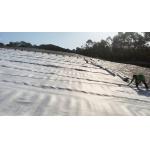Our Smooth HDPE Geomembrane is the industry-standard solution for
creating highly reliable, long-term fluid and vapor barriers.
Engineered from premium high-density polyethylene resins and
manufactured under strict quality control, it delivers unmatched
durability, chemical resistance, and impermeability for the most
critical environmental, hydraulic, and industrial containment
projects worldwide. Key Features & BenefitsSuperior Impermeability & Barrier Performance: Ultra-Low Permeability: Provides an exceptionally effective barrier against liquids
(water, leachate, chemicals) and gases (vapors, methane), with
permeability coefficients typically < 1 x 10⁻¹³ cm/s. Continuous Seam Integrity: Factory and field seams are thermally fused (wedge or
extrusion welding) to create monolithic, leak-tight bonds of equal
or greater strength than the parent sheet.
Exceptional Durability & Longevity: Outstanding Chemical Resistance: Resistant to a vast array of aggressive chemicals, acids,
alkalis, salts, and industrial fluids. Ideal for landfills, mining,
and chemical containment. High Stress Crack Resistance (SCR): Formulated and tested to resist slow crack growth under
long-term stress, ensuring decades of reliable service (ASTM D5397,
FNCT). Robust UV & Weather Resistance: High-quality carbon black stabilization provides superior
protection against ultraviolet (UV) degradation and extreme
temperature fluctuations (-60°C to +80°C). Biological Resistance: Immune to degradation from bacteria, fungi, and root
penetration. Proven Service Life: Designed for service lives exceeding 50+ years under
appropriate conditions.
High Mechanical Strength: Excellent Tensile Strength & Elongation: Withstands installation stresses, settlement, and hydrostatic
pressure without tearing or puncturing easily (ASTM D6693). Strong Tear & Puncture Resistance: Resists damage from subgrade irregularities or cover material
during installation and service (ASTM D1004, D4833). Dimensional Stability: Maintains shape and performance under load.
Cost-Effective & Efficient Installation: Lightweight & Flexible: Available in large rolls (up to 8m+ wide) for faster
deployment, fewer field seams, and reduced labor costs compared to
rigid alternatives. Adaptable: Conforms well to subgrade contours and structural details. Proven Installation Methods: Well-established thermal welding techniques ensure
consistent, high-quality seams.
Environmental & Economic Advantages: Protects Groundwater & Soil: Prevents contamination migration, safeguarding vital
environmental resources. Reduces Liability: Meets stringent regulatory requirements for containment
applications. Sustainable Solution: Contributes to pollution prevention and resource
conservation. Often contains recycled HDPE content (specify if applicable).
ApplicationsLandfill Liners & Caps: Base liners, sidewall liners, final covers, leachate ponds,
temporary covers. Mining & Heap Leach Pads: Solution containment, process ponds, tailings impoundments,
closure caps. Water & Wastewater Containment: Potable water reservoirs, evaporation ponds, treatment
lagoons, anaerobic digesters, aquaculture ponds. Industrial & Secondary Containment: Chemical storage areas, tank liners, spill containment berms,
brine ponds. Aquaculture & Decorative Water Features: Pond and lagoon liners. Tunnels & Infrastructure: Waterproofing membranes, cut-off walls. Agriculture: Irrigation canal liners, manure storage. Energy: Fly ash pond liners, biogas digesters, solar pond liners.
Technical SpecificationsMaterial: High-Density Polyethylene (HDPE) Surface Texture: Smooth (Double-Sided) Thickness: [e.g., 0.75 mm (30 mil), 1.0 mm (40 mil), 1.5 mm (60 mil),
2.0 mm (80 mil), 2.5 mm (100 mil)] (Specify available gauges) Density: ≥ [e.g., 0.940 g/cm³] (ASTM D1505) Melt Index: [e.g., 0.10 - 0.25 g/10 min] (ASTM D1238, Condition 190/2.16)
(Specify range) Carbon Black Content: [e.g., 2.0 - 3.0%] (ASTM D4218) - Uniformly dispersed for UV
protection Tensile Properties (Typical @ Yield): Strength, MD & XMD: ≥ [e.g., 20 MPa / 2900 psi] (ASTM D6693 Type IV) Elongation, MD & XMD: ≥ [e.g., 700%] (ASTM D6693 Type IV)
Tear Resistance (Typical): ≥ [e.g., 125 N/mm] (ASTM D1004) Puncture Resistance (Typical): ≥ [e.g., 350 N] (ASTM D4833 / D5514) Stress Crack Resistance (SCR): Notched Constant Tensile Load (NCTL): ≥ [e.g., 500 hours @ 100% stress] (ASTM D5397) Full Notch Creep Test (FNCT): ≥ [e.g., 500 hours @ 4.0 MPa] (ISO 16770)
Permeability Coefficient (Water Vapor): < [e.g., 1.0 x 10⁻¹³ cm/s] (ASTM E96) UV Resistance: ≥ [e.g., 12 months outdoor exposure with ≤ 50% retained
strength] (ASTM D7238 / GRI GM13) Seam Strength: ≥ [e.g., 90%] of parent material strength (ASTM D6392, D5820) Roll Dimensions: Width: [e.g., 7.0 m, 7.5 m, 8.0 m]; Length: [e.g., 100 m, 150
m, 200 m] (Specify standard sizes) Standards Compliance: ASTM Standards (D6392, D6693, D7176, etc.), GRI-GM13,
GRI-GM19, EPA Subtitle D, NSF-61 (for potable water), EN, and other
relevant national/international specifications. (Specify applicable standards)
Why Choose Our Smooth HDPE Geomembrane?Uncompromising Quality: Manufactured from virgin, high-grade HDPE resins using
state-of-the-art flat die or blown film extrusion technology under
rigorous ISO quality management. Certified Performance: Backed by comprehensive third-party testing reports for all
critical properties (SCR, Tensile, UV, etc.). Consistency Guaranteed: Strict process controls ensure uniform thickness, material
properties, and carbon black dispersion throughout every roll. Global Expertise: Trusted by engineers and contractors for the world's most
demanding projects across diverse climates and terrains. Technical Support & Training: Dedicated team provides specification guidance, design
assistance, and certified welding training programs. Sustainable Manufacturing: Commitment to environmental responsibility (mention specific initiatives if applicable, e.g., recycled content,
energy efficiency).
Installation OverviewSubgrade Preparation: Critical step! Achieve a smooth, compacted, stable subgrade
free of sharp objects, rocks > [e.g., 20mm], voids, and debris.
Geotextile protection layer often recommended. Panel Deployment: Unroll panels according to design layout, allowing for
thermal expansion/contraction. Minimize traffic on unprotected
geomembrane. Thermal Welding: Certified welders use specialized wedge or extrusion welding
equipment to create continuous, destructive-tested seams. Seam
testing (non-destructive & destructive) is mandatory. Detail Work: Meticulous welding around penetrations, pipes, and structures
using extrusion fillet welding or boot details. Cover & Protection: Install designated cover soil or protection layer promptly as
per design specifications to shield from UV and mechanical damage.
|









